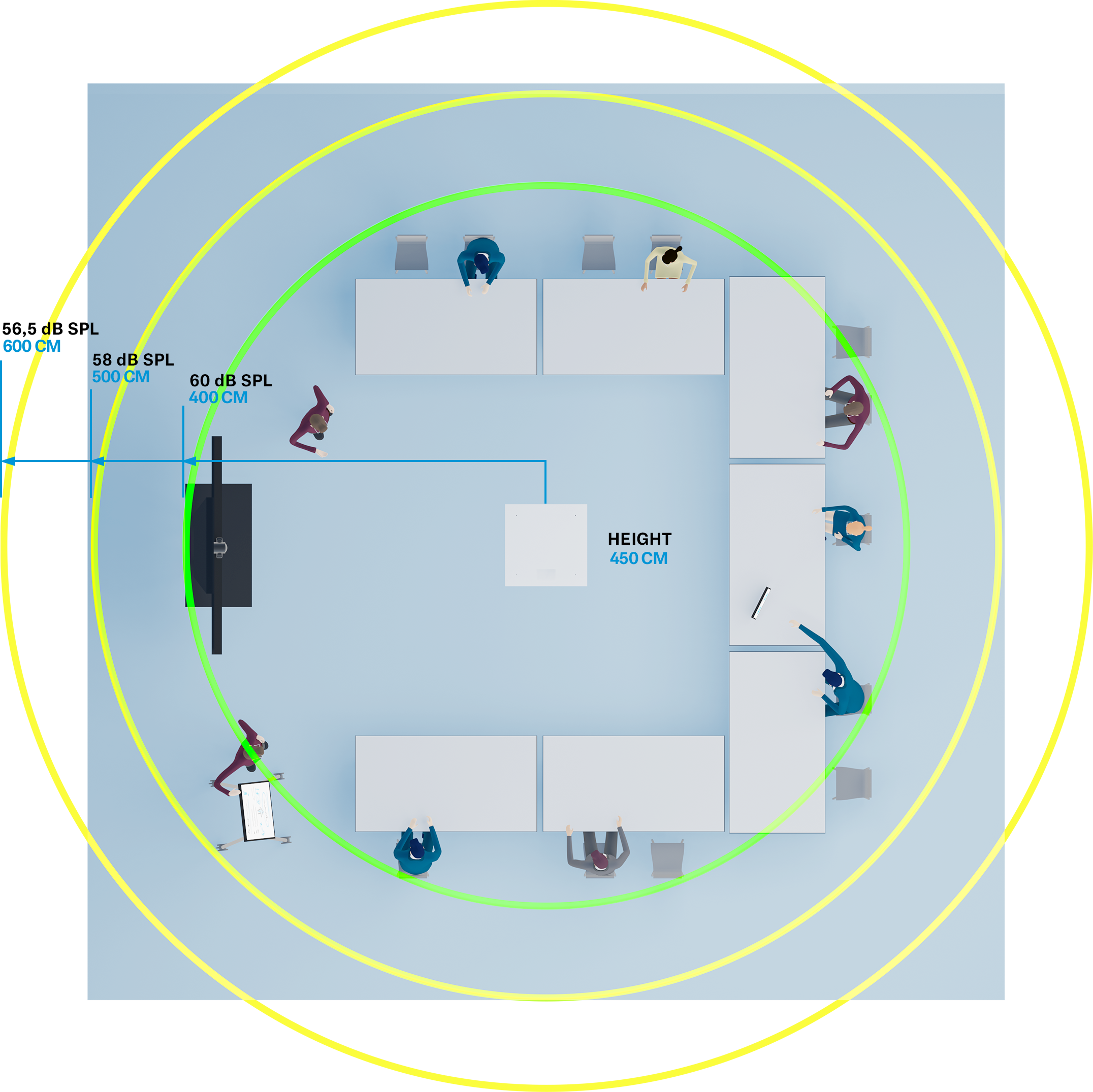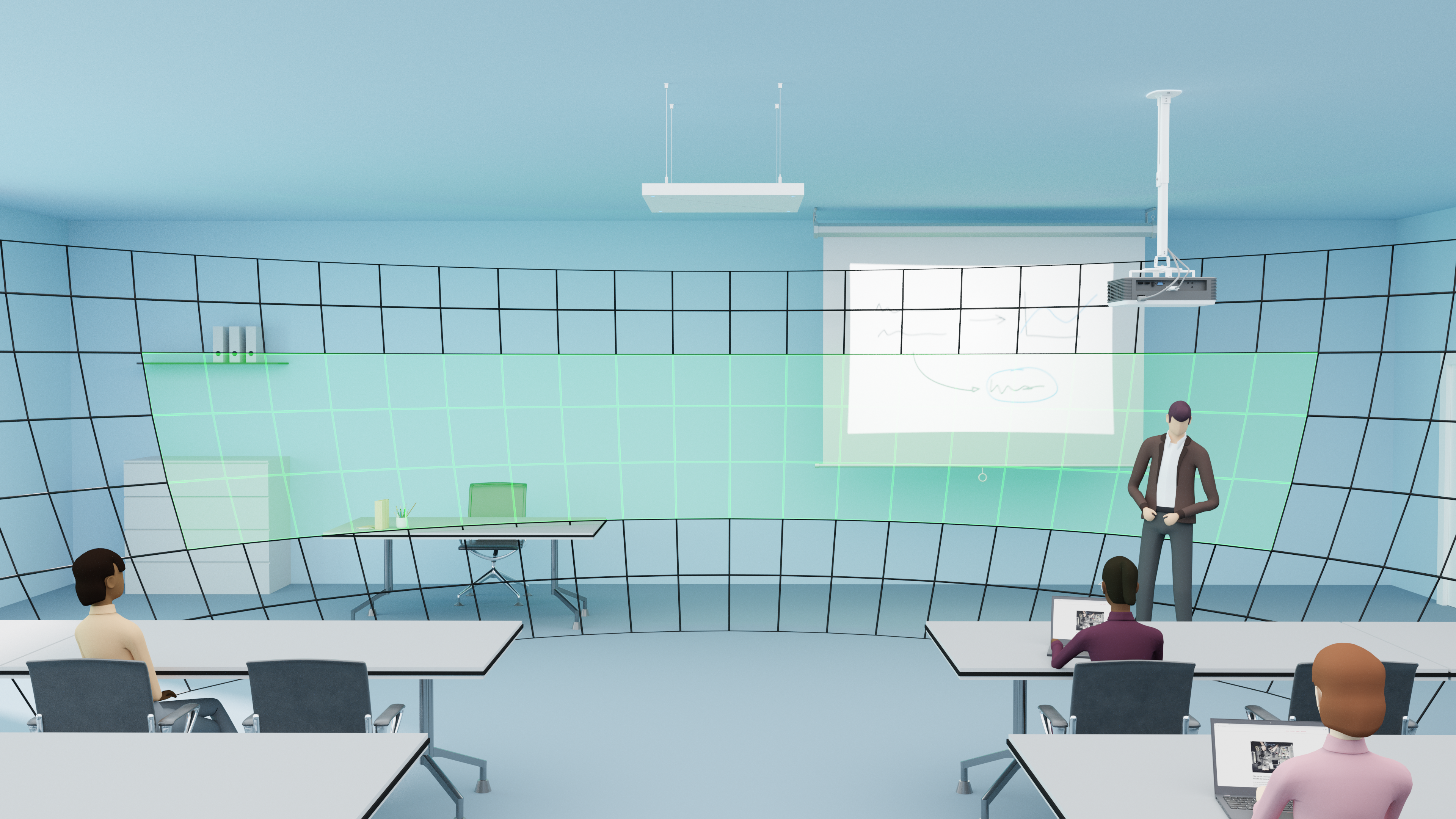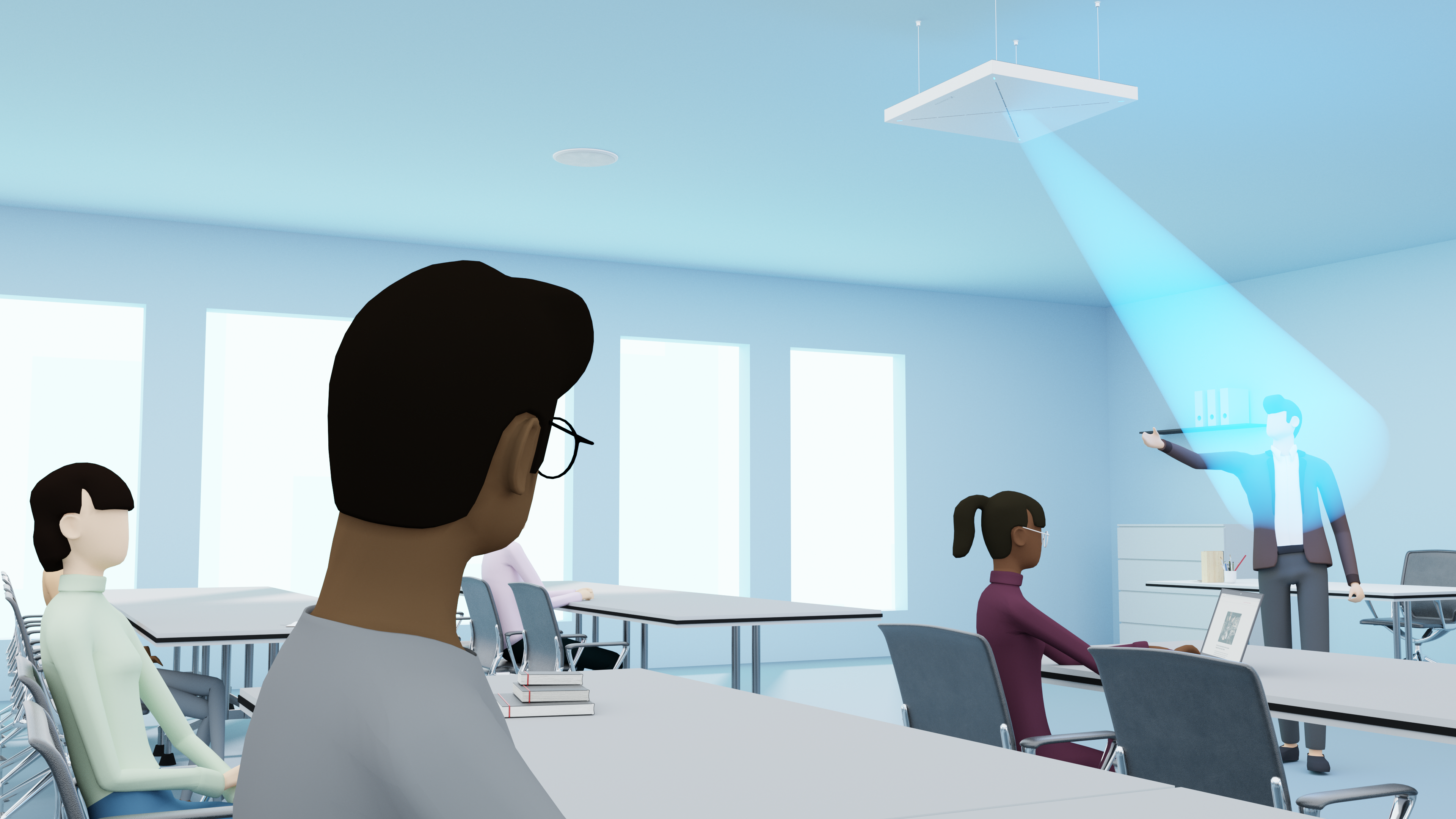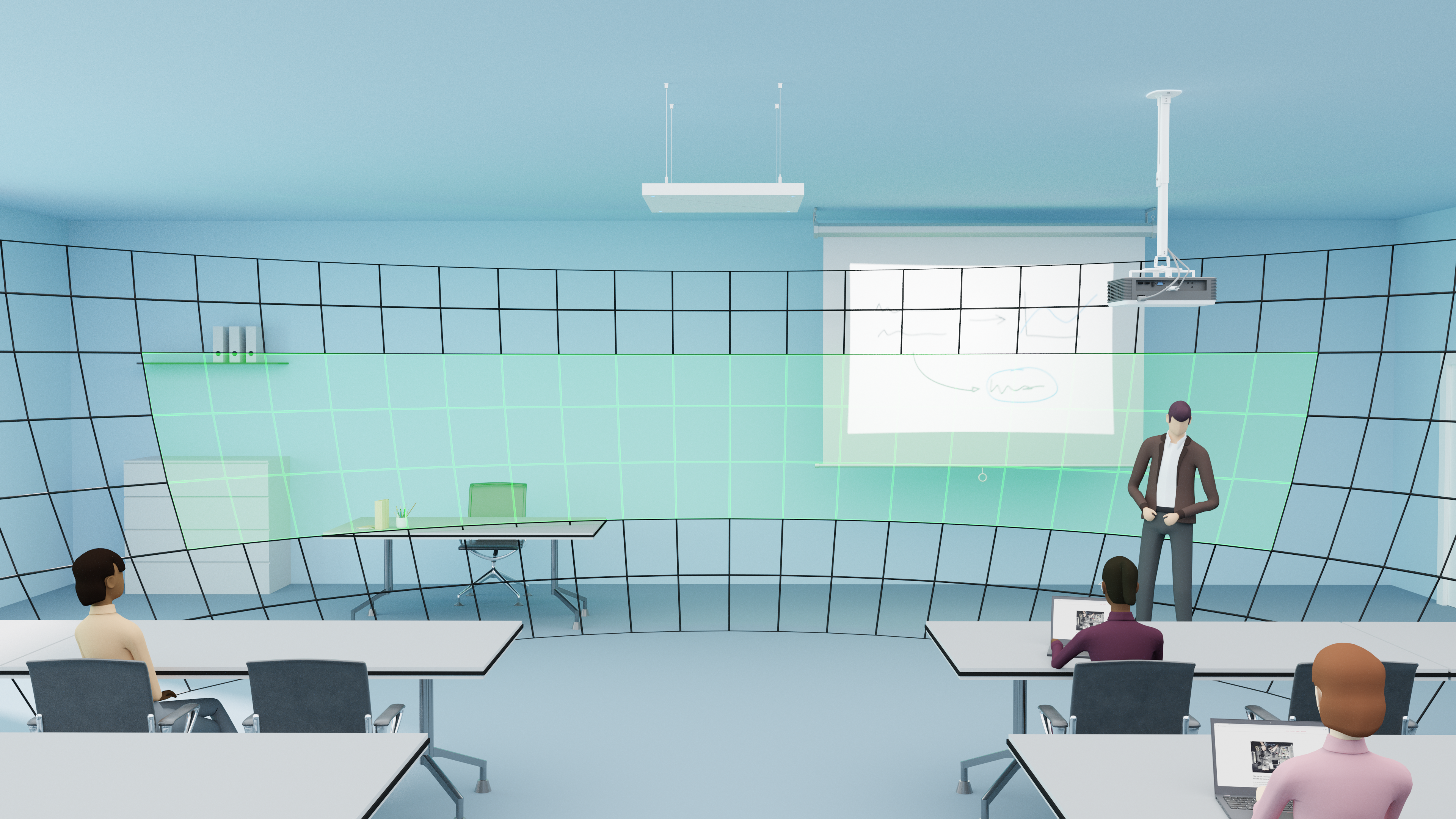Learning equity is vital. Every student needs to have the best opportunity to learn the material for any course of study. This is especially true in higher education classrooms where students are more discerning about the value they receive from the institution. The classroom, especially the hybrid classroom, where remote and in-room students come together in one space, has become a cornerstone of modern-day AV technology. When envisioning a hybrid classroom, we typically think of the visual elements—projectors, smart boards, mobile devices, and cameras that make it possible. However, audio is the most foundational element in creating an exceptional, equitable, and inclusive learning environment. Simply put, when speech is intelligible, students can learn. For everyone in a room to hear clearly and naturally and participate in discussions with ease, large classrooms or lecture halls may require a voice lift system.
Far and Near-end Equity
In the last five years, the Unified Communications (UC) industry has exploded in education. UC technology made it possible for those on the far end (remote students) to attend and participate in classes, events, and discussions. In the hybrid learning space, the far-end experience has been prioritized to ensure students are fully included—they can hear clearly, see presentations, and participate seamlessly. However, for those students attending in-person classes, those classrooms may need specialized audio technology to make sure everyone feels connected and is receiving an equitable experience. Those in the classroom need to feel like they're part of the conversation as much as possible and can hear what's being said in the back of the classroom. Voice lift provides speech intelligibility for whoever is speaking, so everyone in the room can hear clearly.
What is Voice Lift?
Voice lift is an area of audio science that is often misinterpreted. It's not a public address (PA) or sound reinforcement (SR) system. With a conventional PA/SR system, all signals received in the room are boosted to the point where even the most distant presenter can be understood. However, two things happen: In order to achieve a sufficient gain before feedback (GBF), presenter microphones must be worn very close to the body, and good placement can be challenging. In addition, communication from students around the classroom is encumbered by either needing to pass around a microphone or having them move to one. What's more, the front-of-stage loudspeakers in those systems must be quite loud to reach the back of the room. This results in uneven volume levels, where front-row students experience overly loud audio while distant students may struggle to hear.
Voice lift is a more evenly balanced audio system. It was introduced to evenly distribute the presenter's natural speech volume, even to listeners at great distances. It maintains consistent speech levels throughout the room, regardless of distance. Voices sound as clear, close, and natural as possible without a hint of artificial tone or feedback. To achieve that intelligibility, it amplifies audio signals individually while increasing the speech level by 3 to 6 dB above the noise floor. Ceiling microphones and distributed loudspeakers are divided into different zones with their levels controlled by an external DSP system.

When is Voice Lift Needed?
A rule of thumb is that voice lift is used in a room when you have listeners that are 24 feet from the presenter, such as a lecture hall or auditorium, but acoustics can play a role too. If it's a well-balanced, acoustically treated room, then a voice lift system may not be needed. If it's a highly reflective room, then intelligibility will be compromised, making voice lift essential. Anything less than 24 feet, it's harder to control the zones of a voice lift system, but in some cases, such as instructors who are naturally soft-spoken or low-pitched, it may be beneficial. The goal is to achieve intelligibility for all participants in a room.

Voice Lift for Active Learning
Within a voice lift system, even distribution of sound with no feedback is achieved by splitting the loudspeakers and microphones into different zones within the room. The quantity and locations of the zones will be determined by the size and acoustics of the room, the number of listeners, the distance between the microphones and the loudspeakers, and the polar pattern of the chosen loudspeaker. Determining how loud the system needs to be for even coverage and speech intelligibility in the room will require calculating the potential acoustic gain (PAG) and the needed acoustic gain (NAG). This formula is very important in designing a voice lift, or even if one is needed.
The goal is to achieve a value of >=0 dB for the difference of PAG − NAG. This indicates a potentially stable voice lift system. If the calculated value is negative, the system is potentially unstable and could suffer from feedback and insufficient intelligibility.
The following formulas are needed to determine the PAG/NAG value:
PAG = 20*log((D0 * D1)/(D2 * DS)) − 10*log(NOM) − FSM
NAG = 20*log(D0 / EAD)
PAG − NAG = x dB
If x >= 0, this value indicates a potentially stable system.
If x < 0, this value indicates a potentially unstable system, which tends to suffer from feedback.
D0 = Distance between the talker and the farthest listener
D1= Distance between the ceiling microphone and the loudspeaker
D2=Distance between the farthest listener and the loudspeaker
EAD=Distance between the talker and nearest listener
DS=Distance between the talker and the ceiling microphone
NOM=Number of open microphones
FSM=Ceiling microphone feedback stability margin
Here's a PAG/NAG calculation to illustrate:
PAG=20*log((33*10)/(6*7))-10*log(2)-6=17.9
NAG=20*log(33ft/12ft)= 8.78
PAG-NAG= 9.12 dB


A Voice-Lift Scenario
Let's say we have a large classroom where there are two ceiling microphones paired with four loudspeakers. The room is divided into four coverage zones. The first coverage zone includes the teacher's area. When they are speaking, the loudspeaker in their zone does not need to be on. Likewise, the loudspeakers closest to the instructor will be at much lower volume because they can hear the instructor unassisted to some degree, so they need less amplification or voice lift. But as you move away from the speaker and the distance increases, more amplification is needed to hear in the sides or back of the room. Essentially, the back of the room will sound the same to those students as those sitting in the front row. With the ceiling microphones and audio zones, when someone starts to speak in the back, the system will do the opposite, muting the loudspeaker within that zone but applying appropriate amplification so other students, as well as the instructor, can hear that student naturally and equally. The loudspeaker in that zone is muted to avoid a feedback loop. Likewise, the other ceiling microphone for the instructor is muted.
When multiple open microphones are operated at the same time, the systems must be balanced against each other. As interactions between presenters and the audience can often be lively, it is important to manage the interaction between microphones, loudspeakers, and the persons speaking. This is why a DSP is needed. It allows for mix-minus, which refers to the muting or lowering of loudspeaker volume in zones that have active microphones. This will help to avoid feedback in each zone, regardless of who's speaking in the room. The speakers will automatically adjust, depending on which microphone is active.
Challenges with Voice Lift
Feedback can be very problematic in a voice lift system. This is why, in addition to a zoned distributed loudspeaker system, the microphone itself will be an important part of creating an optimal voice lift. It should be a beamforming microphone with strong third-party DSP and matrix mixer manufacturing partnerships. A beamforming ceiling microphone will be able to cover a large area but in very narrow beams. This increases its discernability in what audio it picks up and helps to reject the speakers around it. It's like a virtual shotgun microphone. Microphones that integrate well with the DSP and matrix mixer will allow for the creation of multiple zones of mics and loudspeakers that can be fine-tuned so that mics can be muted as needed and the gain of the speakers can change, depending on which microphone is live.
Microphones Specialized for Voice Lift
In addition to beamforming technology, microphones should include features specifically designed to suppress feedback. Microphones that feature voice lift technology significantly amplify speech within the classroom and activate many processes to automatically suppress feedback. When specifying, designers should look for a solution that employs frequency shifting procedures, which automatically apply algorithms to the microphone output signal to mitigate the risk of feedback from the loudspeakers in the room. This ensures that various frequencies are shifted in real time while maintaining the voice quality. Shifting the frequencies considerably reduces the risk of feedback, as sound is transmitted not as a single wave bundle but in multiple wave packets. It also allows you to achieve higher gain. This frequency-shifting technique is used to achieve the best possible speech results.
Of course, frequency shift won't be needed on the far end, so within a Dante stream, one will be a frequency-shifted stream while the other will be a clean mic signal without frequency shift that's sent to the far end. This gives integrators the ability to balance the system nicely and even get more volume than they might need.
Good Acoustics Can't Be Overlooked
Of course, attaining the best listening and speaking environment comes down to the acoustics of the room. The designer and/or architect should prioritize good room acoustics. A highly reverberant room, which many classrooms can be due to hard, reflective surfaces, should be mitigated before considering a voice lift system. Because it would be impossible to get rid of all reflections, integrators should deploy microphones that make use of any remaining reflective properties of a room. A narrow beam of 30° ensures that excellent speech intelligibility is achieved even in rooms with many reflective surfaces. This focused beam is able to pick up each individual's speech cleanly, even when the presenter is standing with their back to the microphone (e.g., speaking and using a whiteboard at the same time).
Acoustic education for integrators, consultants, designers, and architects is also key. Understanding the impact good acoustics have in a room is a conversation as old as time and stands apart from any trends.
The Future of Learning
Students in higher education today are much more discerning in the educational programs and experiences they're paying for. Schools have to be ready to demonstrate the value of in-person learning. All students entering the classroom, as well as the instructors, want to have a good listening experience. As accessibility and equity become a central focus for all grade levels, audio is an important factor for everyone, especially for those who are hard of hearing.
Live theaters such as Broadway have been implementing voice lift for years. They don't rely solely on stage loudspeakers but also loudspeakers that fill in at balcony seats and under the balcony so the audio for those seats sounds just as even and intelligible as other seats that are closer. People pay good money to go to a play. Why shouldn't the higher education classroom be the same?
As schools get deeper into the journey of designing classrooms built around equitable learning for remote and in-person attendees, it's also important to think about how those same ceiling beamforming microphones integrate with cameras and controllers. For example, if a student in the classroom asks a question, the beam (location) from the microphone works with the camera to activate the correct zone. That way, the person at home can not only hear who's speaking but see them as well. Sennheiser is one of the first manufacturers to provide positioning data and presets for its TeamConnect ceiling microphones for Q-SYS, Crestron, and other camera controllers.
More schools and other organizations are starting to look at voice lift systems and how it can improve the in-room experience. For instructors, they don't have to strain to hear questions, and discussions can happen more organically and naturally, which benefits students who may be anxious about speaking. People want to learn, and instructors want to get the message across easily.

